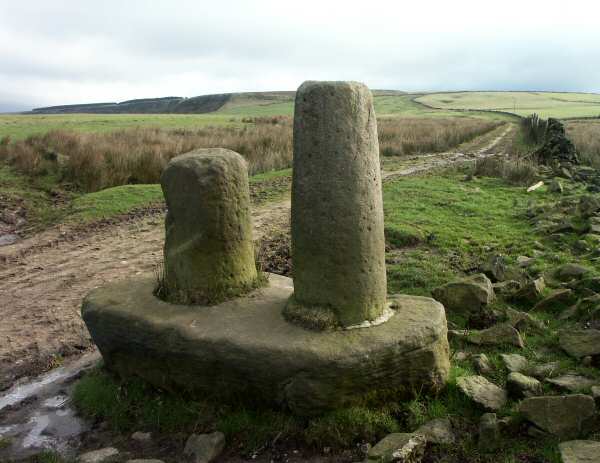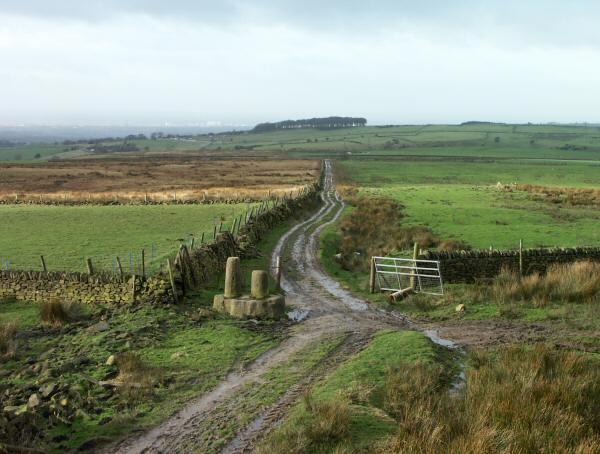

The photo above looks east. It shows the stones standing alongside a track that sweeps down from Cown Edge Rocks. The other photo faces in the opposite direction. It shows the track looping past the stones and heading towards Brownlow (marked by a hilltop clump of trees).

Archaeologists have examined the stones and come to their conclusions. The columns are thought to have been carved in the 9th century AD, by Anglo-Saxons. The stones may originally have been a single column that at some time has been broken and two pieces mounted side-by-side.
Walkers still pause to contemplate them, as countless others have done over the centuries. During that time the columns will have meant different things to different people. It is interesting to sit by them and imagine the possibilities. They include the following.
Druid Stone
It is just possible that the original column is from a period earlier than the 9th century, perhaps Celtic.
If so it could have been used by an earlier religion.
Saxon Cross
This origin is favoured by archaeologists.
As a single column it may have looked like that still standing at Cleulow
and those in West Park, Macclesfield.
It is thought that in the 9th century the local inhabitants were Christian.
Ancient Route Marker
Some old columns mark the course of ancient tracks.
This column is on a track running east-west across country, passing through a gap in Cown Edge and heading towards Brown Low.
It is not far from a crossroads with another ancient track running north-south along the top of Cown Edge.
Forest Boundary Marker
The people of this area resisted the Normans after the invasion of 1066.
In 1070 the Norman army came here for retribution.
They destroyed property and slaughtered animals. They reduced the area to waste.
The Normans then created Macclesfield Forest.
For us, the word "forest" brings to mind an area of land covered by trees.
In the 11th century the word had a different meaning.
It meant an area reserved for hunting.
Macclesfield Forest was a Royal Forest. The hunting was reserved for Royalty.
Local people, having had their other resources destroyed, were banned from taking wild game.
In that era there were few walls and fences.
Marker stones were placed on tracks at the entry to the forest to warn that hunting beyond that point was banned.
It may be the Normans who broke the column (already several hundred years old) and used the pieces to make a boundary marker.
At one time there were four pairs of twin columns in Macclesfield Forest.
Of these, two pairs still exist, Robin Hood's Picking Rods, and Bow Stones.
Robin Hood
The stones bear his name, but who was he, did he really exist, and how is he connected with the stones?
Legends have Robin at the head of a gang of outlaws with names such as Friar Tuck, Little John, and Will Scarlet,
and followed by maid Marion.
They were brave men, skilled with bow and arrow, who were not afraid to break the law by taking game from the forest,
and gold from rich travellers.
Thus they could live well and give food to the poor who lived among the riches of he forest but were banned from using them.
Local legend says that Robin shot an arrow at the Picking Rods (to win freedom for a fair maid).
It is said that the arrow hit the stones leaving the mark that can be seen today.
This legend also has Robin performing an implausible feat of strength on Werneth Low nearby.
Some of the legends may be difficult to believe,
but they are sufficiently strong, persistent, and widespread in this part of the country
to lead one to believe there may be some truth behind them.
Unfortunately they date from the 13th century when little was written down.
Few ordinary people could write.
Those who could write were in positions of power.
They had little incentive to portray a gang of outlaws accurately, and are unlikely to have known the full truth.
Robin could have been used as an excuse by the poor inhabitants of the forest
when they were questioned by the King's Shire Reave (Sheriff) about missing game.
It is difficult to distinguish truth from fiction.
Modern tales about Robin usually place him in Sherwood Forest which starts about thirty-five miles east of here.
However, most of the places named after him or having local tales about him are in Yorkshire and Derbyshire, closer to here.
If Robin did exist, then he and his gang are likely to have passed this way.
Did he marvel at the ancient stones as we do today, or hide in ambush, waiting for a rich traveller?
Tool For Making Longbows
In the 14th and 15th centuries the men of this area were famed for their prowess with the longbow.
They formed the core of the archers who caused havoc for England's enemies in battles such as Crécy and Agincourt.
They also formed the King's personal bodyguard.
There has been speculation that the twin stone columns were a tool for making longbows.
It is possible to see how the columns could be used to bend and string bows.
However, the stones were not portable and would not be much use in war.
A portable wooden tool could do a better job.
It is not likely that the main purpose of Robin Hood's Picking Rods was the manufacture of longbows.
Plague Stone
From time to time an outbreak of bubonic plague swept the country killing many.
By the 17th century it was known that the disease spread from person to person.
During an outbreak, villages would try to isolate themselves from contact with the outside world.
They established a location well outside the village where goods could be left, and payment left in exchange,
without the parties to the transaction coming into contact with each-other.
These locations were often at old standing stones.
There is no specific evidence in relation to Robin Hood's Picking Rods.
However it was common practice in the area.
The stones are highly likely to have been used for that purpose.
County Boundary Marker
Robin Hood's Picking Rods have always been in Derbyshire,
however in 1936 the boundary between the counties of Derbyshire and Cheshire was redrawn.
Previously the boundary had followed the rivers Etherow and Goyt down in the bottom of the valley,
but in 1936 it was moved up to the moors and hilltops.
Yeardlsey and Taxal were transferred from Cheshire to Derbyshire,
balanced by Mellor and Ludworth from Derbyshire to Cheshire.
The stones stand on the edge of Ludworth Moor.
They mark a corner in the revised county boundary.
In the lowest photo the county boundary follows the stone wall, from Brown Low towards the camera.
On reaching Robin Hood's Picking Rods the boundary turns and follows the wall to the left in that photo.
The field above and to the left of the wall was in Cheshire.
This is still the county boundary.
However, since the local government re-organisation of 1974 it is the boundary between Derbyshire and the new county of Greater Manchester.